Module 3 -- Introduction to Circuit Protection, Control, and Measurement
Pages i,
1-1,
1-11,
1-21,
1-31,
1-41,
1-51,
1-61,
1-71,
2-1,
2-11,
1-21,
2-31,
2-41,
3-1,
3-11,
3-21,
3-31,
AI-1,
AII-1,
AIII-1,
IV-1,
Index
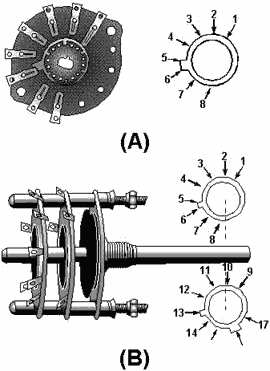
The ACTUATOR of a switch is the portion of the switch which is moved to cause the switch to
change contact positions. The actuator could be a toggle, a pushbutton, a rocker, or, in the case of a rotary
switch, a shaft and handle. The NUMBER of POSITIONS of a switch refers to the number of
points at which the actuator can select a contact configuration. 3-31
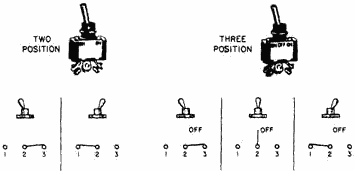
A MOMENTARY POSITION of a switch is one in which the actuator will only stay as long as force
is applied to the actuator. When the force is removed, the actuator (and switch) will return to a non- momentary
position.
A LOCKED POSITION of a switch is used to prevent the accidental movement of the actuator
to or from a specific position.
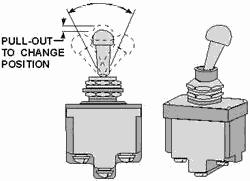
A SNAP-ACTING Switch is one in which the movement of the switch contacts is relatively
independent of the actuator movement. This is accomplished by using a leaf spring for the common contact of the
switch.
A MICROSwitch is an accurate snap-acting switch and the operating point is preset and
very accurately known. 3-32
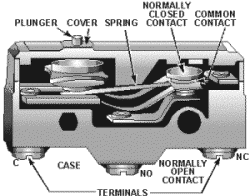
The Voltage RATING of a switch is the maximum voltage the switch is designed to
control. a voltage higher than the voltage rating may be able to "jump" the open contacts of the switch. The CURRENT RATING of a switch is the maximum current the switch is designed to carry; it is
dependent on the voltage rating. Any current higher than the current rating may cause the contacts of the switch
to melt and "weld" together. The contacts of a switch can be checked with an ohmmeter if power is removed
or with a voltmeter if power is applied to the switch. To check a switch, the actuator should be checked for
smooth and correct operation, the terminals should be checked for evidence of corrosion, and the physical
condition of the switch should be determined. If a substitute switch must be used to replace a faulty switch, the
substitute must have all of the following:
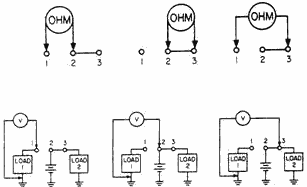 At least the same number of poles, throws, and positions; the same number of breaks and an identical
configuration in regard to momentary and locked positions; and a voltage and current rating equal to or higher
than the original switch. In addition, the substitute must be of a physical size compatible with the mounting, and
must have the same type actuator as the original switch. 3-33
A SOLENOID is a control device that uses electromagnetism to convert electrical
energy into a mechanical motion. The magnetic field of the coil and core will attract the plunger of a solenoid
when current flows through the coil. When current is removed, the spring attached to the plunger will cause the
plunger to return to its original position. If a solenoid fails to operate, check the
terminal connections, the plunger and attached mechanism for smooth operation, the energizing voltage, and the
coil of the solenoid.
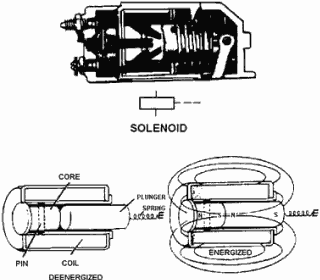
A RELAY is an electromagnetic control device that differs from the solenoid in that the
solenoid uses a movable core (plunger) while the relay has fixed core. Relays are classified as CONTROL RELAYS,
which control low power Common circuits and Power RELAYS or CONTACTORS which control high power circuits. 3-34
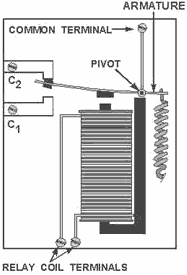
CLAPPER RELAYS use a clapper (armature) to move contact positions and accomplish the
switching of circuits.

Relays are described by the type of enclosure. a relay may be OPEN, SEMIsEALED, or SEALED. 3-35

If a relay fails to function, the movement of the contacts should be observed; the coil should be
checked for opens or shorts; the terminal leads should be checked for burned or charred insulation; and the
contact surfaces should be checked for carbon, arcing, and contact spacing.
A BURNIsHING TOOL is used to clean the contacts of a relay. Files, sandpaper,
and emery cloth should NOT be used.
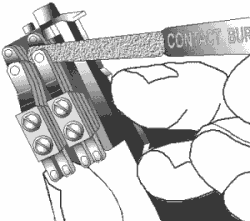
3-36
A Point BENDER is used to adjust contact spacing of a relay. No other tool
should be used.

Answers to Questions Q1. Through Q30. A1. To remove power from a
malfunctioning device; to remove power from a device you wish to work on and restore power when the work is
completed; to turn devices on and off as the device is needed; to select the function or circuit desired within a
device.
A2. Switches, solenoids, and relays. A3. a. Solenoid. b. Switch. c.
Relay. A4. a manual switch must be turned on or off by a person. An automatic switch turns a circuit on
or off without the action of a person (by using mechanical or electrical devices). A5. a light switch,
an ignition switch, television channel selector, etc.
A6. a thermostat, an automobile distributor, a limit switch, etc. A7. Multicontact switches make
possible the control of more than one circuit or the selection of one of several possible circuits with a single
switch.
3-37
A8. a. Three-pole, single-throw (triple-pole, single-throw) b. Double-pole,
double-throw c. Single-pole, double-throw d. Single-pole, single-throw e. Double-pole,
triple-throw f. Six-pole, double-throw A9. a. Single-pole, single-throw, single-break
b. Single-pole, double-throw, single-break c. Single-pole, single-throw, double-break
d. Single-pole, double-throw, double-break e. Rotary f. Wafer g. Double-pole,
double-throw, double-break
A10. The type of actuator. A11. Two-position and three-position. A12. a momentary switch. A13. a locked-position switch. A14. a microswitch. A15. The maximum current a switch is designed to
carry.
A16. The maximum voltage allowable in the circuit in which the switch is installed.
A17. An ohmmeter and a voltmeter. A18. a voltmeter. 3-38
A19. a. Not acceptable-single throw. b. Not acceptable-double break. c.
Acceptable-choice #2 (different actuator). d. Not acceptable-single pole. e. Not acceptable-no
momentary position. f. Acceptable-choice #1 (higher rating). g. Not acceptable-locked position
incorrect.
h. Not acceptable-current rating too low. i. Not acceptable-voltage rating too low.
A20. The switch operation for smooth and correct operation, the terminals for corrosion, and the physical
condition of the switch. A21. The magnetic field created in a coil of wire and core will attract a soft
iron plunger when current flows through the coil. A22. a starter motor and solenoid.
A23. The connections, the plunger, the mechanism that the solenoid actuates, the energizing voltage, and
the coil of the solenoid. A24. The magnetic field created in a coil of wire will attract aft armature
causing a movement in sets of contacts. A25. The solenoid provides a mechanical movement of a plunger (a
moveable core) while the core of a relay is fixed. A26. Control relays and power relays (contactors).
A27. By observing the movement of the contacts if the relay is open or sealed with a transparent cover.
If the relay has an opaque cover, you can "feel" the operation of the relay by placing your finger on the cover.
A28. The coil should be checked for opens, shorts, or a short to ground; terminal leads should be checked
for charred or burned insulation; the contact surfaces should be checked for film, carbon, arcing, and contact
spacing. A29. a burnishing tool. A30. a point bender 3-39
| - |
Matter, Energy,
and Direct Current |
| - |
Alternating Current and Transformers |
| - |
Circuit Protection, Control, and Measurement |
| - |
Electrical Conductors, Wiring Techniques,
and Schematic Reading |
| - |
Generators and Motors |
| - |
Electronic Emission, Tubes, and Power Supplies |
| - |
Solid-State Devices and Power Supplies |
| - |
Amplifiers |
| - |
Wave-Generation and Wave-Shaping Circuits |
| - |
Wave Propagation, Transmission Lines, and
Antennas |
| - |
Microwave Principles |
| - |
Modulation Principles |
| - |
Introduction to Number Systems and Logic Circuits |
| - |
- Introduction to Microelectronics |
| - |
Principles of Synchros, Servos, and Gyros |
| - |
Introduction to Test Equipment |
| - |
Radio-Frequency Communications Principles |
| - |
Radar Principles |
| - |
The Technician's Handbook, Master Glossary |
| - |
Test Methods and Practices |
| - |
Introduction to Digital Computers |
| - |
Magnetic Recording |
| - |
Introduction to Fiber Optics |
| Note: Navy Electricity and Electronics Training
Series (NEETS) content is U.S. Navy property in the public domain. |
|



















